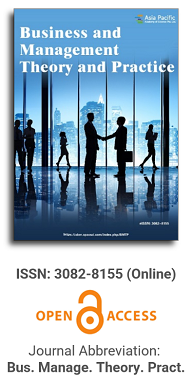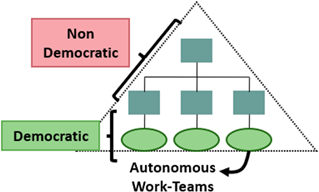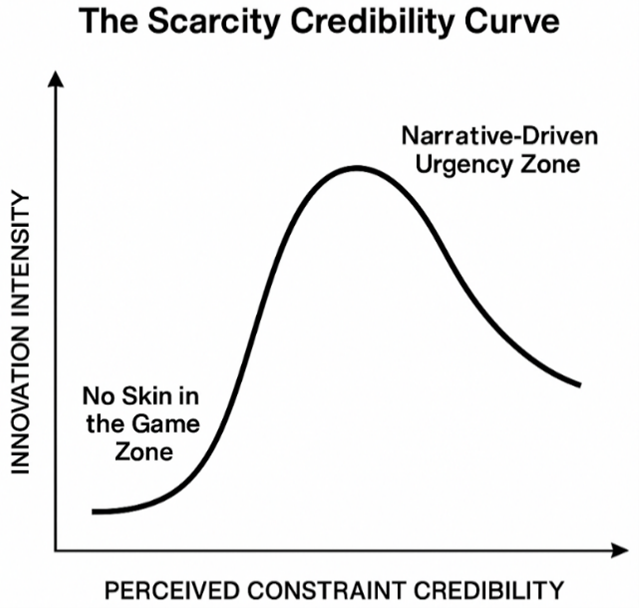
Asia Pacific Academy of Science Pte. Ltd. (APACSCI) specializes in international journal publishing. APACSCI adopts the open access publishing model and provides an important communication bridge for academic groups whose interest fields include engineering, technology, medicine, computer, mathematics, agriculture and forestry, and environment.


Theoretical speculations versus empirical realities: Assessing the van Ruler model of communication
Vol 2, Issue 2, 2025
Download PDF
Abstract
Communication plays a critical role in the success of organizations across all types and sectors. Following a brief overview that demonstrates the diversity of perspectives about communication within organizations, the validity and generalizability of van Ruler’s four-strategy model, or grid, of organizational communication is examined in this study. A scale based on that model was created and subsequently administered to employees in two Iranian workplace settings. Confirmatory factor analyses failed to support the communication strategies proposed by van Ruler, and in initial exploratory factor analyses (EFAs), further disconfirmation of the model occurred because there were only two factors in the data for both samples. Refined follow-up EFAs challenged the model still further because both samples’ data comprised a single factor. We conclude that compartmentalized conceptions of organizational communication may not always apply, but context-specific communication models might still function effectively in certain organizational cultures, especially where hierarchies or formal structures pertain.
Keywords
References
1. Craig RT. Communication theory as a field. Communication Theory. 1999; 9(2): 19–61. doi: 10.1111/j.1468-2885.1999.tb00355.x
2. van Ruler B. The communication grid: An introduction of a model of four communication strategies. Public Relations Review. 2004; 30(2): 123–143. doi: 10.1016/j.pubrev.2004.01.002
3. Yue CA, Zhou A, Page TG, et al. The past, present, and future of internal communication in public relations: A computational review of the emerging literature. Journal of Public Relations Research. 2025; 37: 4–30. doi: 10.1080/1062726X.2024.2329543
4. Dávalos-Mogollón M, Ramírez-Hernández MAS, Turriate-Guzman AM, et al. Internal communication in the Scopus Database: Systematic literature review 2019–2023. In: Nagar AK, Jat DS, Mishra DK, Joshi A (editors). Intelligent Sustainable Systems. Springer Nature Singapore; 2024. Volume 828. pp. 209–217.
5. Verčič AT. Public relations, a home for internal communication. Journal of Public Relations Research. 2025; 37: 1–3. doi: 10.1080/1062726X.2024.2434348
6. Perales-Aguirre AM, Cotito Mujica A, Turriate-Guzman AM, et al. External communication: A systematic literature review 2019–2023. In: Nagar AK, Jat DS, Mishra DK, Joshi A (editors). Intelligent Sustainable Systems. Springer Nature Singapore; 2024. Volume 828. pp. 261–269.
7. Clegg SR, Pitsis TS, Mount M. Managing & organizations: An introduction to theory and practice, 7th ed. SAGE Publications Ltd; 2024.
8. Dasgupta SA, Suar D, Singh S. Impact of managerial communication styles on employees’ attitudes and behaviours. Employee Relations. 2013; 35(2): 173–199. doi: 10.1108/01425451311287862
9. Doyen B, Vlerick P, Maertens H, et al. Non-technical attributes and surgical experience: A cross-sectional study comparing communication styles and attitudes in surgical staff, trainees and applicants. International Journal of Surgery. 2019; 63: 83–89. doi: 10.1016/j.ijsu.2019.02.002
10. Saphiere DH, Mikk BK, Devries BI. Communication highwire: leveraging the power of diverse communication styles. John Murray Business Academic; 2005.
11. Bovée CL, Thill JV. Business communication today, 15th ed. Pearson; 2021.
12. Kreitler S. Communication style: The many shades of gray. Psychological Applications and Trends. 2021; 4: 17–21. doi: 10.36315/2021inpact004
13. Hatfield JD, Huseman RC. Perceptual congruence about communication as related to satisfaction: moderating effects of individual characteristics. Academy of Management Journal. 1982; 25(2): 349–358. doi: 10.2307/255996
14. Penley LE, Hawkins B. Studying interpersonal communication in organizations: A leadership application. Academy of Management Journal. 1985; 28(2): 309–326. doi: 10.2307/256203
15. Chen J, Silverthorne C, Hung J. Organization communication, job stress, organizational commitment, and job performance of accounting professionals in Taiwan and America. Leadership & Organization Development Journal. 2006; 27(4): 242–249. doi: 10.1108/01437730610666000
16. Rogers DP. The development of a measure of perceived communication openness. Journal of Business Communication. 1987; 24(4): 53–61. doi: 10.1177/002194368702400404
17. Vaught BC. An index of interpersonal communicative competence and its relationship to selected supervisory demographics, self-actualization and leader behavior in organizations [PhD dissertation]. North Texas State University; 1979.
18. Widyastuti DA, Purwanta E, Astuti B, et al. Assessing validity and reliability of Muslim student’ interpersonal communication scale: A Rasch model study. Islamic Guidance and Counseling Journal. 2025; 8(1). doi: 10.25217/0020258551200
19. Beauchamp SR. Introduction to human communication, 3rd ed. Sage Publication; 2023.
20. Wijn R, Van Den Bos K. On the social-communicative function of justice: The influence of communication goals and personal involvement on the use of justice assertions. Personality and Social Psychology Bulletin. 2010; 36(2): 161–172. doi: 10.1177/0146167209347382
21. George JM, Jones GR. Understanding and managing organizational behavior, 5th ed. Prentice Hall; 2008.
22. Jones P. Communicating strategy. Gower; 2017.
23. Kim S, Rader S. What they can do versus how much they care: Assessing corporate communication strategies on Fortune 500 web sites. Journal of Communication Management. 2010; 14(1): 59–80. doi: 10.1108/13632541011017816
24. Borca C, Baesu V. A possible managerial approach for internal organizational communication characterization. Procedia—Social and Behavioral Sciences. 2014; 124: 496–503. doi: 10.1016/j.sbspro.2014.02.512
25. Dominick JR. The dynamics of mass communication: Media in the digital age, 8th ed. McGraw-Hill; 2005.
26. Selnes F, Lanseng EJ. Marketing management: A customer-centric approach. SAGE Publications Ltd; 2024.
27. Aitken I. Encyclopedia of the documentary film. Routledge; 2013.
28. Austin EW, Pinkleton BE. Strategic Public Relations Management: Planning and Managing Effective Communication Campaigns, 2nd ed. Taylor and Francis; 2015.
29. Tyagi CL, Kumar A. Advertising management. Atlantic; 2004.
30. van Ruler B, Vercic D. Overview of public relations and communication management in Europe. In: Public Relations and Communication Management in Europe: A Nation-by-Nation Introduction to Public Relations Theory and Practice. Mouton de Gruyter; 2004.
31. van Ruler B. The communication grid of tactics by Betteke van Ruler. Available online: https://bettekevanruler.nl/the-communication-grid-2/ (accessed on 20 February 2025).
32. Balaji MS, Kumar Roy S, Kok Wei K. Does relationship communication matter in B2C service relationships. Journal of Service Marketing. 2016; 30(2): 186–200. doi: 10.1108/JSM-08-2014-0290
33. Besley JC, Dudo AD, Yuan S, et al. Qualitative interviews with science communication trainers about communication objectives and goals. Science Communication. 2016; 38(3): 356–381. doi: 10.1177/1075547016645640
34. Gürel E, Kavak B. A conceptual model for public relations in museums. European Journal of Marketing 2010; 44(1/2): 42–65. doi: 10.1108/03090561011008600
35. Ihlen Ø, Van Ruler B. How public relations works: Theoretical roots and public relations perspectives. Public Relations Review. 2007; 33(3): 243–248. doi: 10.1016/j.pubrev.2007.05.001
36. Le Roux T. The description of South African corporate communication practitioners that contribute to organisational performance. Public Relations Review. 2014; 40(2): 193–215. doi: 10.1016/j.pubrev.2013.11.008
37. Luoma‐aho V, Vos M. Towards a more dynamic stakeholder model: Acknowledging multiple issue arenas. Corporate Communications: An International Journal. 2010; 15(3): 315–331. doi: 10.1108/13563281011068159
38. Mahdieh O. Interaction between communication and organizational conflict and its relationship with performance. International Journal of Business Administration Studies. 2015; 1(2): 54–60.
39. Treurniet W, Messemaker M, Wolbers J, et al. Shaping the societal impact of emergencies: Striking a balance between control and cooperation. International Journal of Emergency Services. 2015; 4(1): 129–151. doi: 10.1108/IJES-06-2014-0007
40. Van Woerkum C, Aarts N. Staying connected: The communication between organizations and their environment. Corporate Communications: An International Journal. 2008; 13(2): 197–211. doi: 10.1108/13563280810869613
41. Schermelleh-Engel K, Moosbrugger H, Müller H. Evaluating the fit of structural equation models: Tests of significance and descriptive goodness-of-fit measures. Methods of Psychological Research. 2003; 8(2): 23–74.
42. Hu L, Bentler PM. Cutoff criteria for fit indexes in covariance structure analysis: Conventional criteria versus new alternatives. Structural Equation Modeling: A Multidisciplinary Journal. 1999; 6(1): 1–55. doi: 10.1080/10705519909540118
43. Gaskin CJ, Happell B. On exploratory factor analysis: A review of recent evidence, an assessment of current practice, and recommendations for future use. International Journal of Nursing Studies. 2014; 51(3): 511–521. doi: 10.1016/j.ijnurstu.2013.10.005
44. Hair JF, Black WC, Babin BJ, Anderson RE. Exploratory factor analysis. In: Multivariate data analysis, 7th ed. Pearson Education; 2014. pp. 89–149.
45. Patil VH, Singh SN, Mishra S, Donavan DT. Parallel analysis engine to aid in determining number of factors to retain using R. Available online: https://analytics.gonzaga.edu/parallelengine/ (accessed on 20 February 2025).
46. Yang A, Taylor M. Looking over, looking out, and moving forward: Positioning public relations in theorizing organizational network ecologies: Positioning public relations in theorizing organizational network ecologies. Communication Theory. 2015; 25(1): 91–115. doi: 10.1111/comt.12049
47. Daft RL. Organization theory and design, 10th ed. South-Western Cengage Learning; 2010.
48. Robbins SP, Coulter MK. Management, 14th ed. Pearson Education; 2018.
49. Robbins SP, Judge T. Essentials of organizational behavior, 14th edition. Pearson Education; 2018.
50. Harris TE. Applied organizational communication: Principles and pragmatics for future practice, 2nd ed. Lawrence Erlbaum; 2002.
51. Harris TE, Nelson MD. Applied organizational communication: Theory and practice in a global environment, 3rd ed. Erlbaum; 2008.
52. Adams CA, Frost GR. The internet and change in corporate stakeholder engagement and communication strategies on social and environmental performance. Journal of Accounting & Organizational Change. 2006; 2(3): 281–303. doi: 10.1108/18325910610690090
53. Badea M. Social media and organizational communication. Procedia—Social and Behavioral Sciences. 2014; 149: 70–75. doi: 10.1016/j.sbspro.2014.08.192
54. Green M. How an organization’s CSR communication style makes or breaks consumer trust: Strategic reputation building on Twitter. Annals in Social Responsibility. 2018; 4(1): 7–9. doi: 10.1108/ASR-03-2018-0003
55. Kollat J, Farache F. Achieving consumer trust on Twitter via CSR communication. Journal of Consumer Marketing. 2017; 34(6): 505–514. doi: 10.1108/JCM-03-2017-2127
56. Langer E. What’s trending? Social media and its effects on organizational communication. Journal of Undergraduate Research. 2014; XVII: 1–10.
57. Siljanovska L. The influence of social media on organizational communication: case study in Republic of Macedonia. European Journal of Interdisciplinary Studies. 2015; 3(1): 83–92. doi: 10.26417/ejis.v3i1.p83-92
58. Wang G. Culture, paradigm, and communication theory: A matter of boundary or commensurability. Communication Theory. 2014; 24(4): 373–393. doi: 10.1111/comt.12045
59. Rhee Y, Moon B. Organizational culture and strategic communication practice: testing the competing values model (CVM) and employee communication strategies (ECS) model in Korea. International Journal of Strategic Communication. 2009; 3(1): 52–67. doi: 10.1080/15531180802608386
60. Smith PB. Communication styles as dimensions of national culture. Journal of Cross-Cultural Psychology. 2011; 42(2): 216–233. doi: 10.1177/0022022110396866
61. Amir S. The influence of national culture on communication practices: a case study on Malaysian organisations [PhD dissertation]. Queensland University of Technology; 2009.
62. Giri VN. Culture and communication style. Review of Communication. 2006; 6(1–2): 124–130. doi: 10.1080/15358590600763391
63. Brown AD, Starkey K. The effect of organizational culture on communication and information. Journal of Management Studies. 1994; 31(6): 807–28. doi: 10.1111/j.14676486.1994.tb00640.x
64. Scholderer J, Veflen N. Social norms and risk communication. Trends in Food Science & Technology. 2019; 84: 62–63. doi: 10.1016/j.tifs.2018.08.002
65. Almaatouq A, Alhasoun F, Campari R, Alfaris A. The influence of social norms on synchronous versus asynchronous communication technologies. In: Proceedings of the 1st ACM international workshop on Personal data meets distributed multimedia; 22 October 2013; Barcelona, Spain. pp. 39–42.
66. Berezan O, Yoo M, Christodoulidou N. The impact of communication channels on communication style and information quality for hotel loyalty programs. Journal of Hospitality and Tourism Technology. 2016; 7(1): 100–116. doi: 10.1108/JHTT-08-2015-0031
67. Visser B. Organizational communication structure and performance. Journal of Economic Behavior & Organization. 2000; 42(2): 231–252. doi: 10.1016/S0167-2681(00)00087-1
68. Juodvalkis JL, Grefe BA, Hogue M, et al. The effects of job stereotype, applicant gender, and communication style on ratings in screening interviews. The International Journal of Organizational Analysis. 2003; 11(1): 67–84. doi: 10.1108/eb028963
69. Ng CW. Do women and men communicate differently at work? An empirical study in Hong Kong. Women in Management Review. 1998; 13(1): 3–10. doi: 10.1108/09649429810369587
70. Vaught BC, Pettit JD, Taylor RE. Interpersonal communication behaviour of male and female administrators. International Journal of Educational Management. 1989; 3(2). doi: 10.1108/EUM0000000001947
Supporting Agencies
Copyright (c) 2025 Author(s)
License URL: https://creativecommons.org/licenses/by/4.0/

This site is licensed under a Creative Commons Attribution 4.0 International License (CC BY 4.0).

Macau University of Science and Technology, Macau




.jpg)
.jpg)
